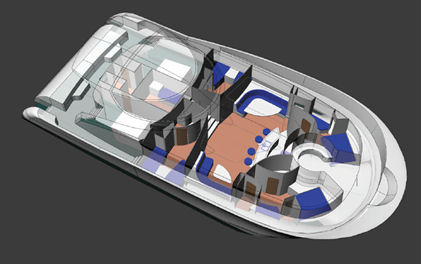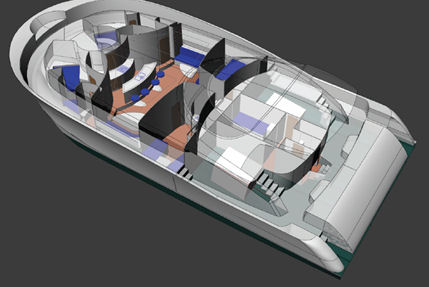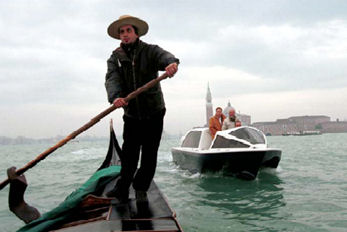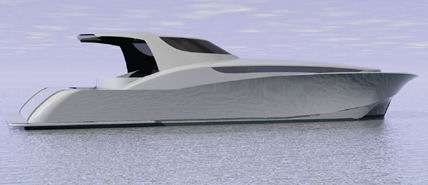Expedition Motoryacht of the Future
They won’t fit behind houses in Ft.
Lauderdale, but that’s a good thing because this design is intended for people who
want to go places, lots of them, and in virtually any kind of weather. Readers might
recall the article we published a fortnight ago about “Darth Vader’s” latest. Well,
this is that boat’s recreational little sister. If you have something against catamarans,
forget it because this design is beyond that. She is intended to go 45 knots WOT,
but we’d like to see her go 20 knots and sip fuel. She has four staterooms below,
crew quarters, plus a 30’ wide main salon. And that’s just the beginning.

|
|
A CAD drawing of the Mangia Onda 65 showing what interior space could be like. Renderings by Tim Kernan. |
Her designer tells us that she’ll have a WOT of 45 knots
and have a “fuel efficient cruising speed of 30 knots” powered by twin Cat C-30s.
While we think that fuel efficiency and those 1550-hp engines is an oxymoron, we
still like the concept. We would just power it with something like Yanmar’s 900-hp
8SY-STP. After all this is not your everyday motoryacht. This is a boat that could
go virtually anywhere in the world – like across the Pacific – with the right kind
of engines and fuel management.
Specifications
M Ships, the design company that owns the patent to the “M” hull, and we assume
the double “M” design as well, calls this boat the “Mangia Onda 65.” Mangia onda
means “wave eater” in Italian. It displaces 35 tons and draws only 2.1 feet, which
must be a record of some sort. She is intended to carry 2500 gallons of fuel, which
at the right speed with the right engines, can get this boat a long way.
Why not carry more fuel? We suspect that like cats, she is weight sensitive.

|
|
Note the crew cabin aft with engine spaces port and starboard. |
Since this boat is just a glint in her designer’s eye, we have no idea what her
fuel consumption numbers will be. But since she will be a custom boat her prospective
owner can dial in just about any speed he wants under the 45 knots that her naval
architect says she can get with the 5,616-lb. (X2) Cat C-30s.
But the most impressive aspect of this design after what should be great fuel efficiency,
will be her ride. A smaller version of the military vessel featured last week, she
should ride almost as well. Her designers say she will have an “unparalleled offshore
ride quality”, but of course naval architects have never been known for modesty.
Room for a Square Dance
They say that the accommodations have never before been achieved in a 65’ yacht,
and that we can believe. After all this boat will have something over a 2,000-sq.
ft. footprint. Most people live in houses smaller than that.
Join us now, as we quote from M Ship’s understated description of the boat—
“The flowing curves of the hull are carried throughout the design as sweeping bulkheads
take advantage of the expansive beam to offer truly grand spaces. The main salon
stretches over 30’ in width, and serves as a nucleus of all activities below deck.
The galley, bar, lounge and dining areas all share this space while creating the
sense of an Italian piazza.
“When pampered seclusion is preferred, four staterooms adjoin the salon allowing
for quick and inviting access.”
Pampered seclusion? Quick and inviting access? We hope the bulkheads are well insulated.

|
|
Perhaps the keyhole in the bow is for viewing those in “pampered seclusion.” Perhaps it is for a dining table like the Apreamare designs. |
Crew quarters are aft as are the two engine rooms. The designer says that there
is a large garage under the aft deck for personal watercraft, tenders and gear.
About the Unique Hull
The boat’s M-hull is unique in several ways. A narrow central displacement hull
rises to wings extending laterally on each side that support an outer vertical skirt.
This skirt recaptures the bow wave created by the central hull and forces it to
flow through channels between the hull and the skirts. Ceilings in the channels
slope down to the waterline at the stern, converting bow wave energy into boat lift
for improved performance and a dramatically reduced wake effect.

|
|
In the background is a 22’, 10 passenger, Venice water taxi designed by M Ship to reduce wakes. |
"At low speeds the wake of an M-hull is approximately 50% less than that of any
conventional hull", said Bill Burns, Managing Partner of the M Ship Company, "and at
higher speeds wake is virtually eliminated. We knew the design would reduce wakes,
but discovering that ride quality was also enhanced and propulsion efficiency was
boosted by about 20% made it a real winner that's now drawing interest from organizations
all over the world."
Quo Vadis?
What is the next step? It sounds as if it is about time for a world cruiser like
Bruce Kessler to step up and have one of these boats designed for himself and thereby
bake in years of practical experience. We suspect such boat would look quite different
from the one above. We’ll keep you posted.

